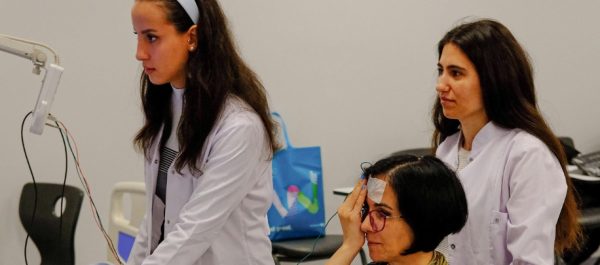If your child has visual problems that aren't picked up and addressed, their learning could be significantly impacted. Contact us to book a reading clinic appointment today.
Struggling to read?
Visual problems can have a huge effect on the everyday life of a child or adult, but particularly on both their ability to learn and their enjoyment of learning.
A reluctance to read, struggling with school work and conditions like dyslexia and visual stress or migraines, can all be helped by having a more in-depth eye examination and our optometrists can determine whether eye exercises, glasses, overlays, or glasses with specific lenses or a specific tint could alleviate or eliminate such visual symptoms.

If reading, writing, spelling, or maths are a concern for you or your child, this tailor-made appointment starts by going through detailed questions to get a clearer picture of your difficulties. We then conduct a detailed in-depth eye examination and binocular vision assessment. We assess whether a coloured overlay appears to help, and then measure the rate of reading with and without the overlay to measure the effect that a coloured overlay might have. We put all this together and tailor-make a plan for your child. This may include eye exercises, specific reading glasses and perhaps a coloured overlay or tinted reading lens.

Dyslexia
We specialise in visual problems that can further impact on conditions like dyslexia by using specific equipment and highly trained optometrists to spot problems and diagnose the best solution. Some visual problems are hard to identify through a standard eye sight test and require a different approach. Although not everyone who has dyslexia has visual problems, for those that do, they can contribute to the reading difficulty.
We also recognise that if a child or adult is dyslexic, they may find sections of a standard eye test difficult, so we tailor-make each test to suit them and their needs.
Visual Stress
Do the words on a page move? If this is something your child describes, they may have visual stress or Irlen Syndrome, a visual processing disorder which can cause sensitivity to visual patterns particularly stripes and the condition can interfere with reading.
Visual stress symptoms can occur with normal vision. When describing the symptoms, children often say that the words on a page move or jump, that they are blurry or explain that some have colours around them.

Signs that a child is suffering with visual stress often include: moving closer or further away from the book, skipping words or lines, rubbing of the eyes, frequent blinking and poor understanding of the written content.
Visual stress can sometimes (but not always) be improved by the use of coloured filters, either placed over words or through lenses in glasses. This is determined by selecting the most effective coloured overlay for the individual, and then the effect of that overlay measured, for example by by using a rate of reading test. If it is effective, the overlay is given for home and school use. If it has a good and positive impact on vision, then we offer you the option of having a pair of tinted glasses, for ease.

How can coloured lenses help?
After a thorough eye examination one of our optometrists might identify that coloured overlays that are used for reading can help or they may prescribe glasses with tinted lenses. People find the tinted lenses much more convenient than overlays for help with reading in their everyday lives.
In our specialist clinics, we have helped many adults and children to read more easily, most often by correcting refractive error or helping with accommodative issues or binocular imbalances. We only prescribe a coloured overlay if it demonstrably works during the assessment. We assess this with Wilkins Rate of Reading. If the child / adult then finds this overlay invaluable at home, school or work, we will prescribe tinted glasses if requested. The right colour combination can result in improved reading, comfort and confidence. The degree in which tinted lenses can improve reading differs from person to person. Some people experience no benefit. However, some people see an improvement instantly.
Migraines
About 40 per cent of all migraines are triggered by flickering light, patterns or reading. If you or your child is experiencing migraines we may ask you to complete a headache diary. This helps us to track how frequent they are, helps to identify what triggered them and their severity.
Recent research has shown that coloured lenses also have an impact on helping to reduce/stop migraines.

If you have any questions, or you would like to book an appointment
Get the latest news & updates
Sign up with us to receive all our latest news and information


